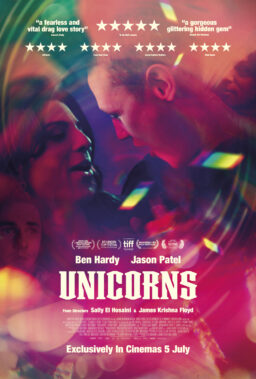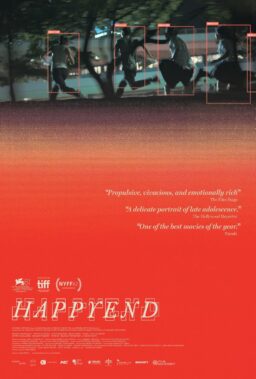The committee found five better pictures, is the glib explanation.
–Bruce Davis, exec. dir., Motion Picture Academy.
Like almost everyone who was stunned last week when “Hoop Dreams” failed to be nominated for an Academy Award as best documentary, I was stumped by one obvious comeback: “Have you seen the five films that were nominated?” I had not.
“The nominating committee simply found five films it thought were better,” its chairman, Walter Shenson, told me. “We see all the films. Our critics do not.” Shenson added that he personally had given “Hoop Dreams” his highest rating.
He had a point. I had not seen the five nominated films–so how could I be so sure “Hoop Dreams” was better than them, and deserved to be nominated?
Now I have the answer. I have seen the five films. I was able to view them in the last few days. And I am afraid my answer is: Yes, “Hoop Dreams” is better than all five of the nominated films, and a lot better than three of them.
There are basically two kinds of documentaries: Those about events that have already happened, and those about events that happen as the film is being made.
In the first category fall traditional documentaries like Ken Burns’ “Civil War.” The second category includes films from the “cinema verite” movement, in which the camera follows people as they lead their lives, and the filmmakers cannot predict the outcome. This category would include “Hoop Dreams,” which followed two Chicago youths for five years, from grade school to junior college, as they followed the dream of becoming professional basketball players.
Some films of course straddle these categories; an example would be Michael Moore’s “Roger & Me,” which combines documentary footage of Flint, Michigan with present-day confrontations between Moore and his targets. Other documentaries, like Errol Morris’ “The Thin Blue Line,” fall outside of both categories: They’re basically reconstructions of events.
Great films can be made in all of these styles. What is obvious is that the committee that chose this year’s Oscar nominees were fond of documentaries about things that have already happened. They do not seem receptive to cinema verite.
“They’re old-fashioned and they go for documentaries made up of talking heads and stock footage,” Barbara Kopple told me. The winner of two documentary Oscars (for “Harlan County, U.S.A.” and “American Dream“), she makes movies that unfold as they are being photographed; at one point in the earlier film, about a miners’ strike, a company guard actually fires a shot at a camera.
* “Talking heads and stock footage.” It is important to understand what she means. The filmmaker gathers archival, newsreel and television footage from as many sources as possible, and ties it together with new footage of people who are interviewed talking about the events we see. Sometimes there is a narrator.
* “Cinema verite.” It is helpful to understand this term, too. There is usually not a narrator, and the camera tries to be a fly on the wall, unobserved, as real events unfold. In “Hoop Dreams,” there are moments we can barely believe–like the one where 15-year-old Arthur Agee, recruited by a suburban high school to play basketball, then dropped from the squad and from his paid scholarship, is coolly told his transcript cannot be released until he pays his tuition. In that scene is the kind of truth you do not find any other way.
The volunteers on the Academy’s documentary nominating committee attend movies four hours a night, two nights a week, for nearly three months. It is a hard job, and one would be grateful for their effort–if only they did it better. They must like talking heads and stock footage, because all five of their 1995 nominees fall in that category.
Of the five films they nominated, two are not feature-length. One (“Complaints of a Dutiful Daughter”) is 44 minutes long, and another (“D-Day Remembered”) clocks in at 54 minutes. The committee likes brevity; committee confidante and former member Mitchell W. Block, whose company Direct Cinema distributes “D-Day Remembered,” was quoted as saying, “If ‘Hoop Dreams’ had come in at a tight two hours, it might have sailed right through.” (The film’s 165 minutes did not seem too long, however, to the most severe critics of running time, the film editors, who nominated it for an Oscar in their category.)
* * *
Viewing the five nominees was, for me, an enjoyable experience. I will be giving four of them favorable reviews.
* Frieda Lee Mock’s “Maya Lin: A Strong Clean Vision,” is a film about the young Chinese-American woman who designed the Vietnam Veterans’ Memorial in 1982, and about the extraordinary decade in her life that followed. We learn how she entered the competition, and learned she had won it. Then there is the extraordinary bitterness her design aroused. Today, when the memorial is hailed as a triumph of public sculpture, it is easy to forget the vicious attacks by such as Pat Buchanan and Rep. Henry Hyde (who thought it should be white, be above ground, and have a flagpole at the apex). There is an unforgettable shot of Lin’s face, her eyes solemn and sad, as her design is attacked at a hearing.
Then we see how well the Memorial works today, and the familiar rituals of those visiting it. The film moves on to show Maya Lin’s designs for the Civil Rights Memorial in Montgomery, Ala., and other works, including a sculpture made from tons of broken glass. There is not much about Maya Lin herself in the film–the personal details are limited to memories of childhood–but there is a strong sense of her personality and work, and we wonder that one so young could not only have survived the tempest surrounding the construction of the Vietnam Memorial, but continue to grow without letting fame affect her.
* “A Great Day in Harlem,” by Jean Bach, Matthew Selig and Susan Peehl, has great imagination in its choice of subject matter. Its inspiration is a historic photograph taken for Esquire in 1958, showing all of the jazz greats who could be assembled on one front stoop in Harlem. It interviews as many of the people involved as could be found, including the photographer, Art Kane; the art director, Robert Benton; surviving jazz musicians (Dizzy Gillespie, Art Blakey, Bud Freeman, Buck Clayton and others). There is also inspired footage of jazz performances from the period, and the movie is introduced by the great 1944 jazz short “Jammin’ the Blues.”
What we are left with is a memory of a time gone by, when there really was a jazz community, when the key figures knew one another, when commercialism had not replaced invention. We hear about who came early and who came late, who made them laugh and who made them worry, who dressed to be noticed and who blended in, and how all the kids from the street got into the shot. It is not only a wonderful film, but a wonderful idea: Starting with an old photograph, a day and an age are brought back to life.
* “Freedom on My Mind” is a film about the flowering of the civil rights movement in the 1950s and 1960s. Produced and directed by Connie Field and Marilyn Mulford, is uses archival footage of freedom riders, sit-ins, marches, voter registration drives and Klan rallies to evoke the reality of those days, and then talks to some of the surviving participants.
The historic footage, gathered from newsreels and TV broadcasts, is stark and moving, if largely familiar. The present-day witnesses recall those years as the watersheds in their lives, but the film is not always clear about who it is talking to, or why: Bob Moses, who organized voting rights drives, is well established, but unless you already knew that Endesta Ida Mae Holland grew up to be a playwright, you would not learn it here. What is most deeply impressive is the courage of the people of all races who put their lives on the line to end segregation. The movie does well what has been done before; it would be at home in a classroom.
* “Complaints of a Dutiful Daughter,” by Deborah Hoffman, proves the principle that a compelling film can be made without regard for cost or equipment. Seemingly photographed by the director’s friend on a home video camera, it tells the story of the gradual descent into Alzheimer’s Disease of her mother, Doris. The director tells the story while sitting at her desk, talking into the camera: The early signs of memory loss, the “periods” when her mother grew fixated on note-taking, or packing her bags, or stocking up on Lorna Doones.
The film is a little vague on one crucial point. Although it shows Mrs. Hoffman living independently in an apartment, and then moving into a residence for Alzheimer’s patients, it is unclear about just when the move was made, leaving the impression that the mother was living on her own after the time when that was really safe for her. Of course one of the points of the film is Deborah Hoffman’s reluctance to take her proud mother’s independence away.
* “D-Day Remembered,” directed by Charles Guggenheim, is the one film of the five I cannot review favorably. It held my attention, yes, but it is limited in its ambition and technique. Here we don’t have talking heads, only stock footage: Newsreel and Signal Corps film showing the preparations for the landing at Normandy, its terrible toll, and the ultimate Allied success. Much of this footage is very familiar; I have seen certain shots many times before.
The film’s narrator tells us things while the film illustrates them, but the pictures and words may not really match. “It was no secret to the Germans that an Allied invasion was imminent,” the narrator intones, while we see old Nazi footage of two officers talking, then looking out a window. Who are they? When and where was the shot taken? Were they really discussing the imminent invasion? You don’t ask such questions about a film like this.
Along with the narrator (David McCullough), there are many other voices on the sound track–“character voices,” including Southerners, British, African-Americans, Irish and Germans, with bits of comment (“They were first class, the Airborne! They were spot-on!”). The film is vague about these voices; the end credits lists many names under “those who were there,” but are these the voices of actual participants? Some sound too young.
* * *
Now to the bottom line: Are these “five better films” than “Hoop Dreams?” I would say they are not. “Hoop Dreams” was a film that cut to the bone, that gave us the sensation of watching lives unfold. It told more about the lives young black men in American cities than any other film I have seen. It showed their families, their neighborhoods, their dreams. The filmmakers spent years following William Gates and Arthur Agee, along the way discovering moments I will not soon forget.
The five nominated films are all moving and worthy, and “Maya Lin” and “A Great Day in Harlem” are more than that: They deserve theatrical release, and will get a warm reception from me when they open. “Freedom on my Mind” will provide context and history for those who do not know about the watershed of the civil rights struggle. Anyone who has seen a loved one fight Alzheimer’s will be moved by Deborah Hoffman’s testimony. And the D-Day film, much as it resembles countless other entries in the “Victory at Sea” genre, records a crucial chapter of history.
Still, none of them is anywhere near the film that “Hoop Dreams” is.
But…it’s all a matter of opinion, right? I think one thing and you may think another.
True, criticism is all opinion. Well, almost all. Once, a long time ago, a former colleague of mine said in a review that “The Valachi Papers” was better than “The Godfather.” The next time I saw him, I told him: “Every once in a while, matters of opinion stray over into errors of fact.”











